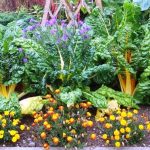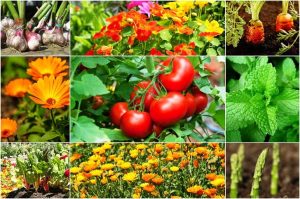by Ken Lain, the mountain gardener
There are plants that work well together and plants that should be kept apart. Matching the two groups into a garden plan is often difficult, especially in small spaces. Companion Planting tomatoes are relatively easy.
Companion planting is part experience, part folklore, and part wishful thinking. Native Americans were amongst  the first to use companion plants to improve vitality. Iroquois legend states planting corn, beans, and squash together helps all three plants thrive and produce a better harvest. Many gardeners still practice this method of growing called the “Three Sisters” today.
the first to use companion plants to improve vitality. Iroquois legend states planting corn, beans, and squash together helps all three plants thrive and produce a better harvest. Many gardeners still practice this method of growing called the “Three Sisters” today.
Luckily tomatoes make good companions with the majority of popular garden vegetables. Some companions help improve health and vigor of tomato plants, some improve tomato flavor, and yet other companion plants are used to repel and deter insect pests and diseases. You’re probably going to grow some of these plants anyway, so why not experiment on your own and use them as companion plants for your tomatoes.
A lot of plants are touted as improving the health, vigor, and flavor of tomatoes. All of these features are hard to measure, little scientific research has actually been done to back up the claims and many other factors may be involved. Still, it’s interesting to try them out in your own garden.
 If you want to have the biggest and best tomatoes, consider companion planting. Here are ten plants that will help your tomatoes taste delicious.
If you want to have the biggest and best tomatoes, consider companion planting. Here are ten plants that will help your tomatoes taste delicious.
Carrots – and tomatoes share space well. You can plant carrots when tomatoes are small and will be ready to harvest by the time the tomatoes are getting larger and needing more room. If you are short on space, this is a great way to increase your garden’s yield.
Marigolds – Many gardeners would never consider growing tomatoes without marigolds. These bright and chipper annuals do a mighty wonder when it comes to deterring pests. They produce a substance known as alpha-terthienyl. This substance reduces root-knot nematodes in the soil.
Leaf lettuce – If you grow leaf lettuce with your tomatoes it acts as a mulch to keep tomato plants cooler. It also helps reduce the chance that disease will spread from the water and soil to your tomato leaves.
Chives – This pretty herb not only helps improve the taste of tomatoes but also helps repel aphids and makes a great addition to any tomato salad.
Borage – This annual herb planted with tomatoes helps in a number of ways. It deters tomato hornworms and cabbage worms. In addition, it improves tomato health and flavor.
Mint – is an aromatic perennial herb that can become invasive. It is best to plant mint in your garden in pots so it does not overrun the garden. Although we may think the aroma of mint is lovely, pests really detest it. Planting some mint near your tomato plants will even keep small rodents at bay.
Garlic – alongside your tomatoes helps keep spider mites away. Besides, who doesn’t like a little fresh garlic in their tomato salad?
Calendula – although often called pot marigold, is an entirely different plant. Both the leaves and blooms of this plant are edible and taste delicious in salads. When planted between tomato plants, calendula is a natural way to control pests that feast on tomato plants. These pretty flowers also look sweet in a salad.
Nasturtiums – These classic annual flowers not only add color and cheer to your garden but also do wonders protecting your tomato plants. They deter whiteflies, squash bugs, beetles, and aphids while keeping fungal disease at bay. Although they are annual, they often reseed making them an even more delightful garden addition.
Asparagus – This yummy perennial vegetable produces a chemical that kills nematodes. Tomatoes contain solanine, a substance that is toxic to the asparagus beetle. In addition, tomatoes grow tall, creating shade around asparagus plants, thus not allowing weeds to grow.
If you want the most from your tomatoes this year, consider some of these companion plants.
Until next issue, I’ll see among the many organic tomato plants here at Watters Garden Center.
Ken Lain can be found throughout the week at Watters Garden Center, 1815 W. Iron Springs Rd in Prescott, or contacted through his web site at WattersGardenCenter.com or FB.com/WattersGardenCenter .

